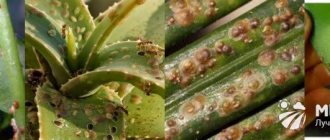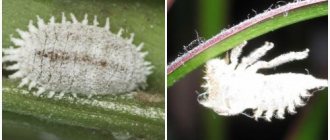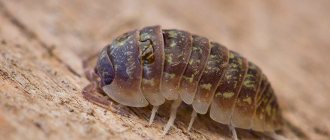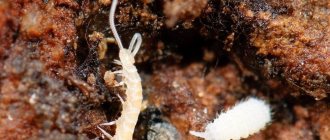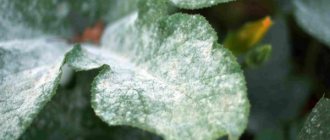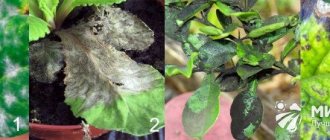Varieties of white bugs
In the soil of indoor flowers, one miniature insect goes unnoticed. But after a few days, a colony of pests actively sucks out the plant’s juices. External signs of infection: spots on leaves, stems, curled leaves, wilted flowers, fallen buds.
There are several types of white pests:
- Aphid. The maximum size of an adult is 2 mm. The colors of aphids are very diverse; on indoor plants they can be found in light gray, white, green, red, etc. The body has an elongated shape, small legs, and straight antennae. It reproduces extremely quickly. Small white bugs feed on the juices of the plant, thereby leading to the complete death of the crop.
- Spider mite. White insects appear suddenly in the soil of indoor plants, unnoticed by humans. The mite body size does not exceed 2 mm. When flowers are heavily infested, a clear symptom of the presence of this pest is the presence of cobwebs on the back of the leaf. The result of the vital activity of the parasite is spots, dried, curled leaves. Females take refuge in the soil, under rotting leaves.
- Root mite. Insects live in flower pots in moist soil. They parasitize bulbous plants - tulips, gladioli, hyacinths. They live directly in the soil, feeding on the bulb itself. As a result of active life activity, the flower gets sick and dies.
- Mealybug. Small white bugs in indoor flowers no larger than 3 mm in size. An oval flat body with growths, covered with a dusting in the form of flour. Long tentacles are visible on one side. A sign of the life of a mealybug is a white coating on the leaves, stems, and soil.
- Springtails. Small bugs with an oblong, translucent body live in soil with high humidity. They feed on dead organic matter and do not harm the plant. Externally, the springtail is similar to a caterpillar, but with legs. The mustache is clearly visible on the head.
White pests
White bugs on flowers can disappear on their own if living conditions change - the soil dries out, the temperature drops, etc., but in most cases human help is required. Otherwise, the plant gets sick, dries, loses strength, and dies.
Pests of indoor flowers and measures to combat them. First and second parts.
1. Aphids. Perhaps I’ll start with a fairly simple pest, since it’s quite easy to notice it on a plant; it settles in large colonies, usually on the fleshier, juicier and more tender parts of the plant, leaving a sticky, sweetish coating behind. These are small insects, approximately 0.5-2 mm, have an ovoid body, long legs, and come with or without wings. They reproduce super quickly) maybe because aphids do not always need a female to reproduce; aphids often breed their own “clones”. There are many species and they are distinguishable by color, usually from yellowish, greenish (greenhouse aphid) to black (beetroot).
Aphids, if there are a lot of them, can greatly weaken the plant. Inspect plants in summer, as aphids are carried by the wind when windows are open. I became familiar with these pests a long time ago. I won’t say that in the garden you can always see it on one plant or another, not always on a home plant, but there are chances. An aphid has settled on my guzmania. The struggle was quite easy and painless for the victim herself. First, I bathed in the shower, tilting my growth point so that water would not pour in there. Using laundry soap, I went through all the leaves with a foam sponge. Thus, I got rid of both insects and sticky plaque. I let it dry and sprayed it with Fitoverm. A week later I examined the plant, there were no aphids, but for peace of mind I sprayed it again)
Folk remedies for deliverance (tested by forum participants)
— zoo shampoo against ticks and fleas. Dissolve a small amount and spray the plant (3-4 times)
— Garlic infusion: Grind 20-30 grams of unpeeled garlic in a meat grinder, add 1 liter of water, leave for 1 day.
- Pour 100 g of dry citrus peels into 1 liter of warm water and leave for three days in a warm place. Then spray.
Insecticides against aphids - Fitoverm, Intavir, Aktara, Konfidor.
2. Thrips.
Did you know that you can encounter thrips almost every day?) How? Take an onion bulb and remove the top layer of peel. Could the second layer of husk be sticky and unpleasant? And even with a silvery tint) This is it, or rather not the bug itself, but its action. You can also sometimes notice an adult individual on the bulb. By the way, it is also easy to find on dandelions) they, like a “jack-in-the-box”, always crawl out of the axils of the petals.
Thrips are not so easy to spot on a plant. Its body is elongated and slender, measuring from 0.5-2 mm (rarely up to 5 mm). The color is unsightly, often black, gray, brown. The larvae are white-yellow and grayish. There are a lot of varieties - bulbous thrips, dracaena, rose, tobacco, decorative.
In general, these comrades are omnivores) they can eat both a delicate rose and a not-so-delicate cactus. Therefore, inspect not only the infected plant, but also the one standing nearby, even if it is a 2-meter palm tree)
Larvae and adults suck cell sap from plant tissue. This initially causes yellow or discolored spots, streaks, or a peculiar streaking appearance; gradually these strokes and spots merge. Damaged plant tissue dies, resulting in holes; leaves wither and fall off. Flowers lose their decorative effect and fall off prematurely.
When infested en masse, “silver” areas are visible on the plants, and curvature of the stems is often noted. Thrips-infested plants show traces of excrement.
As a preventive measure, humidify the air in the apartment; thrips do not like humidity. Give your plants a shower, it's useful. Inspect the undersides of the leaves.
Thrips is my friend at the moment, since he settled on my hibiscus. The saddened hibiscus now stands on the reservation with other plants that stood side by side. You are the one to blame(
Getting rid of thrips is not easy, but it is possible. What did I do? She took the hibiscus to the bathroom, diluted 2 ml of fitovrem into 200 ml and began to carefully spray each leaf, thereby knocking down both the larvae and the parent itself under the pressure of the stream. I wrapped the hibiscus in a bag. The place where the plants stood was washed with disinfectants. I removed the top layer of soil from the hibiscus and added a new one. I'm waiting for re-processing. In total, you need to do 3-4 treatments with an interval of 4-6 days.
Insecticides effective against thrips - Fitoverm, Aktara, Vermitek, Confidor.
Folk remedies work for small infestations, but for severe infestations you need to use insecticides!
Attention! Thrips are carriers of many plant diseases. After getting rid of thrips, it is advisable to treat the plant with a systemic fungicide.
3. Scale insect, false scale insect.
In fact, there are many varieties of them and they can be eaten, like all thrips)
The body of an adult scale insect has a hard, waxy shield, which is why spraying with insecticides does not always work on them. However, young insects do not yet have a scutum. Larvae and adult females suck plant juices. Scale insects can be from 0.5 mm to 5 mm in size. The shield can be either round or elongated. False scale insects, or coccids (Coccidae)
They differ from true scale insects in that they do not have a waxy shell.
Scale insects and pseudoscale insects secrete a sticky liquid on which sooty fungus can settle.
Females are immobile, but males can even fly during their lives . However, the life cycle of the male is very short. They live only a few days, unlike females, who live for several months.
Prevention - spraying the plant and ventilating the premises.
I became acquainted with the scale insect a long time ago, when my mother brought me one infected flower. It’s not easy to get rid of it because of the shell, but again it’s possible and necessary. It is advisable to mechanically remove them from the plant. Gently, without damaging delicate tissues. If there are a lot of them on some part of the plant, if possible, then it is better to cut off the damaged part.
If the injury is minor, alcohol diluted with soap will help you. You can carefully wipe the areas where scale insects accumulate with a cotton pad. In case of severe damage, use only insecticides and be sure to water the plant, not just spray it.
Remedies against scale insects - Aktara, Bankol.
4. Whitefly.
It’s beautiful when butterflies fly) ... but not at home and not when there are a huge number of them)
A small white butterfly, no more than 3 mm, which settles mainly on the underside of the leaf. Fuchsias are most susceptible to whitefly, especially when kept warm in winter, as well as pelargos, especially fragrant, royal and angels, also when kept warm. Whiteflies also love mint)
It is easy to detect if you lightly touch the infected plant; many white small butterflies fly into the air. A shiny coating often appears on the upper side of the leaves. A sooty fungus likes to appear on whitefly feces, causing the leaf to first turn whitish and then turn black. Whiteflies are carriers of viral diseases!
The whitefly is a pampered companion, therefore, by observing the temperature limits inherent in each plant in its individual period, the risk of its occurrence is sharply reduced.
For prevention in summer and winter, you can water the plants with Aktara solution. This is usually enough to prevent whiteflies from appearing.
Poisons - Aktara, Konfidor, Mospilan, Fufanon.
Folk remedies - garlic infusion and cool conditions.
In the second part we will discuss mites, soil scale insects, nematodes, springtails, fungus gnats, etc.
py.sy. thank you very much to the site
Pests of indoor plants. Control measures. Part 2.
So here's the second part. Here we will look at the remaining pests and how to deal with them. In this article I did not write my measures of struggle, I did not make it too personal. If you have any questions, write.
1. Spider mite. Almost all gardeners know this enemy by sight, because it is one of the most common pests. It occurs unexpectedly and is difficult to notice at first glance until the plant makes it known that it is sick.
Visible signs - in advanced cases, a cobweb is visible, at the first signs of damage - small white dots on the back of the leaves, drying out, yellowing of the leaves, the plant sheds its leaves, deformation of the growing leaves and buds.
The life activity of the tick, as well as its reproduction, directly depends on the air temperature. The higher it is, the better it is for the tick. It is worth noting that under poor conditions for ticks (cold weather, high air humidity), females can hide in the soil, under fallen leaves, or cracks in pots. Therefore, when caring for a plant, it is important to collect dry leaves, wipe the leaves with a damp sponge or wash them in a warm shower.
Control measures include spraying the plant with effective acaracid preparations, such as Fitoverm, Actellik, Fufanon, Neoron, Sunmite, Nissoran, Oberon, Omite-30, Bi-58, Admiral, Karate.
From available means - Green soap, laundry soap, pet shampoo for fleas and ticks.
It is important to combine several poisons, since ticks adapt to poisons quite quickly.
2. Flat mite or flat mite. Red mite.
It often settles on ficus, citrus, euonymus, cacti, aucuba, and palm trees.
This mite does not produce webs and at room temperature from 18-25 degrees it behaves very actively. It is more difficult to detect, but it is possible.
The leaves of the affected plant curl and dry out. Yellowish or grayish streaks appear on the leaves. Its lesions are somewhat similar to those of thrips.
Control measures are the same as for spider webs.
3. Cyclamen mite.
This comrade loves to eat cyclamens and violets, pelargoniums. Unlike spider mites, they love moisture. Therefore, the higher the air humidity, the better for it. It settles mainly on the upper side of leaves, the center of violet rosettes, tubers and cyclamen leaves; in large clusters it resembles dust. It is microscopic, so you won’t be able to see it without a magnifying glass. Lays eggs in cracks and depressions.
Traces of damage are curling and yellowing of leaves, deformation of leaves, “dust” on the leaves.
Control measures.
Spraying with pesticides (see above), generously wetting the leaves. Twisting out infected leaves and buds of cyclamen. Reduced air humidity. Removing flower stalks from violets.
4. Root mites.
Microscopic and very tenacious mites. More popular is the bulb mite, which likes to settle on the bulbs of gladioli, hyacinths, and tulips. It eats away the tissue of the bulbs and lays a huge number of eggs. A damaged bulb becomes loose and easily falls apart in your hands.
It loves humidity, so the main prevention is to store the bulbs and tubers in a dry and cool place!
It is worth mentioning here about Soil Mites.
There are mites in any substrate and you should not be afraid of this. Therefore, there is no need to be scared and stock up on poison when you see a tiny and transparent spider on the ground. Mites are of great importance for the normal functioning of the soil as a nutrient medium for plants. Among them there are also predatory mites that feed on pests of indoor plants. By the way, there are biological “poisons” against plant pests, these are these same predatory mites.
These mites are not dangerous for plants, but if there are too many of them in the soil, you should think about mistakes in caring for the plant.
5. Nematodes.
Round, small worms that live in moist soil on plants. They affect various plant tissues - roots, leaves, stems, buds.
As a result, plant growth is inhibited, the plant stem is bent and deformed, leaf petioles are underdeveloped, short internodes, and leaves die off. “Galls” or thickenings appear on the roots.
Security measures:
1. Do not take soil from the area where crops are grown.
2. Do not take questionable soil mixture or sterilize it thoroughly.
3. Disinfect tools, pots, trays.
Control measures.
Use of a systemic nematicide (carbosulfan).
6. Enchitrea.
Small, about 1 cm, ringed white worms that live in contaminated soil.
They feed on the roots of the plant, so the affected plant lags in growth, falls out, yellowing of the leaves occurs, and then the complete death of the plant. Waterlogging of the soil contributes to the appearance of enchytrae.
Control measures.
Washing the roots of the plant from the old soil, replanting it in new soil. Spill of soil by Aktara.
7. Mealybug.
Sucking insects are about 3-3.5 mm in length. Oval body with growths, usually whitish or pinkish. They settle mainly in the leaf axils of the plant, and in case of large infestation - on the leaves and stem of the plant.
A winged insect has one pair of wings. The larvae can settle on the root collar of the plant. The eggs are protected by a cotton-like secretion.
The affected plant sheds its leaves, shoots lag behind in growth, and sooty fungus often forms on the mealybug secretions.
Control measures.
Removal of adults manually or using a cotton swab. Spraying with systemic insecticides Fitoverm, Aktara, Vermitek.
8. Root mealybug.
White, 2-3 mm long. They settle on roots and well-aerated substrates. It can only be discovered by digging up the plant.
The affected plant partially loses turgor, sluggish appearance, deformation and death of leaves.
Cacti and succulents are most susceptible.
Control measures.
Spill the soil with actelik, karbofos, actara, decis several times with an interval of 5-7 days.
Folk remedy. https://floralworld.ru/illnesses_wreckers/rhizoecus.html
9. Springtails, fools.
Small white insects that live in moist soil. They feed on organic residues in soils.
Podurs can move in the soil in a unique way. Some species have a special organ on the abdomen, the so-called “jumping fork,” with which it makes jumping movements. Some species do not have a jumping fork; they crawl on the ground.
A number of springtails harm the plant, like green sminutur, which eats into the roots of greenhouse plants. Some carry fungal spores that can cause plant infection. In general, springtails are harmless to plants, but they even benefit them, playing a major role in soil formation.
Control measures.
Do not allow the soil to become waterlogged. Keep the plant in drier conditions. Cut the raw potato into halves and place it cut side down on the soil. After the insects stick around the potato, take it out and throw it away.
10. Fungus gnat, sciarids.
A small flying black and gray insect with a narrow body and a rounded head. Adults do not harm plants, but their larvae living in moist soil can gnaw at the tender roots of the plant.
Inspect the soil, if you do not see mosquito larvae in the ground, then there is no need to panic, it is enough to destroy the flying insects using sticky tape or dichlorvos. If there are larvae, then you need to sprinkle the soil with Bazudin, Grom-2, Pochin powders.
Control measures.
Do not over-water the soil. Keep the plant in drier conditions.
For flying individuals - tape, neo-dichlorvos.
For larvae - powders Grom-2, Bazudin.
How to get rid of white bugs in the soil of indoor plants
Professional preparations and folk remedies are used to control pests. The choice depends on the individual preferences of the grower and the number of parasites.
- Aktara. Universal insecto-acaricidal agent. Destroys adult individuals, imago. White bugs die within 30 minutes. The product continues to act for another 20 days, preventing re-infection. Does not harm the plant, helps to recover. 4 g of the drug is enough for 5 liters of cold water. Spraying is carried out in a well-ventilated area or outside.
- Actellik. Broad-spectrum insecticide. Destroys pests in 20 minutes and continues to work for another 20 days. Sold in ampoules of 2 ml, designed for 5 liters of water. The solution is prepared immediately before use. Plants are sprayed outdoors. The drug is toxic and requires strict adherence to the instructions.
- Inta-Vir. An insecticidal preparation for treating any plants in open or closed ground. The tablet dissolves in 10 liters of water. Spray the flowers in a well-ventilated area. Does not affect vegetation, helps restore strength.
Ways to fight
There are many methods and means for eliminating pests on indoor flowers; which one is suitable and effective depends on the conditions of detention and the correct treatment of the plants.
- A sick plant with signs of emerging pests must be placed in a quarantine zone, completely excluding its proximity to any types of plants. This could be a separate window sill in another room or a bathroom.
- It is worth deciding on the type of insects or worms that have affected the indoor flower. If pests are not visible on the leaves from above, you need to inspect the axils, trunk and shoots. If the pest is not detected, but the plant is withering, its leaves have dropped, and it has not been flooded or fed with fertilizer before, then you will have to pull it out of the ground and inspect the root system.
- The choice of a drug or folk remedy that can be used to remove pests depends on the degree of damage.
- Mechanical - with minimal infestation of visible insects, which can be removed from the plant by hand, rinse the leaves with water or spray the product. These include the scale insect.
- Folk remedies for protecting plants from pests are also used with minimal damage to areas on flowers.
- In case of severe damage or a large number of pests, natural or chemical-based preparations are used.
Before choosing a drug, it is important to familiarize yourself with the hazard class of the drug and its effect. When the plant is not significantly affected, it is better to use folk remedies or biological preparations with a low level of toxicity, only if they do not help try with more aggressiveness
When the plant is not significantly affected, it is better to use folk remedies or biological preparations with a low level of toxicity, only if they do not help to try with more aggressiveness.
1 – extremely dangerous;
3 – moderate toxicity;
| Non-systemic | System | Specific acaricides | Insectoacaricides |
| Fitoverm, Vertimek, Karbofos, Bankol, Malathion, Akarin, Fufanon, Actellik, Iskra-M, Inta-Vir. | Tanrek, Aktar, Konfidor, Extra. | Flumite, Envidor, Sunmite, Neoron, Oberon. | Fitoverm, Aktelik, Vertimek, Aktofit, Fly eater, Thunder. |
Protecting indoor flowers - folk remedies
Compliance with agricultural techniques for caring for flowers and preventive measures will not give insect pests a chance to destroy the plants.
it is very important not to flood the soil and not to overdry it; do water treatments, spraying, showers for indoor flowers 1-2 times a month.
Folk remedies will help prevent the colonization of indoor flowers by pests, especially scale insects, aphids, thrips, and fungus gnats:
| Means | How to use and dilute? |
| Manganese (potassium permanganate, KMnO4) | Watering into the soil: 1-2 crystals of manganese per 1 liter of warm water, so that the solution becomes pale pink. Watering is carried out every 4-5 days, 2-3 times no more. Foliar treatment with the same solution is carried out daily, spraying the diseased plant for no more than 5 days in a row. Before each spraying procedure, you should irrigate the flower leaves with plain water. |
| Iodine | 1 tsp. for 10 liters of water, suitable for spraying and spilling soil once every 10 days. |
| Iodine + soda ash + laundry soap | Only for spraying against aphids, scale insects, gray rot. For 5 l. water 5 ml iodine and 1 tbsp. soda and soap. Stir thoroughly, pour into a spray bottle and spray once every 10 days. |
| Alcohol tincture of calendula | For 1 liter of water, 10 ml of tincture, a solution only for external irrigation of leaves. As a preventive measure, once every 10 days for a month. When infested with pests, apply once a day for 5-7 days. |
| Tea tree essential oil | 5 ml per 3 l. water, spray daily for 5-10 days, depending on the degree of pest infestation. |
| Tobacco dust | 100 gr. tobacco dust, pour 2.5 liters. water and add 1 tsp. liquid laundry soap. Leave for 2 days, strain and spray the plants once every 2 days, 5 procedures. |
| Onion scale | Pour 1 cup of onion scales into 2 liters of hot water, leave for 24 hours, strain, add 1 tsp. soap Irrigate the leaves 1 r per day for 3-7 days. |
| Laundry soap | Mix 2 tablespoons of liquid laundry soap in 1 liter. Spray the diseased plant with water and leave for a day. The next day, rinse off in the shower and spray with the solution again, repeating the procedure for 3 days. |
Even more information about pests on indoor flowers is in the video:
How dangerous are household pests?
Photo of an adult fool with multiple magnification
To be fair, it should be noted that only some species of collembola are classified as pests. But there are springtails that eat nematodes and enchytraeids, thereby bringing benefits. Insects feeding on rotting organic matter improves soil formation. The white fool is one of those four species of “brothers” that stand out for their harmfulness from the more than 4 thousand that live on earth. We can talk about the danger of insects in the case of a sharp growth of the colony, when there is not enough rotting residue in the pots to feed, and the thinnest thread-like roots of the root system begin to be eaten. Most often, orchids, violets, and gloxinias fall into the risk zone.
Attention! The appearance of springtails in indoor flowers is an indicator of waterlogged soil in pots and flowerpots and improper care of plants.
Where do pests on indoor plants come from?
Pests of indoor plants do not initially live in apartments. There are several ways they can appear in your home, which can sometimes be difficult to protect against. But if you regularly inspect both the plant itself and the soil in a pot or flowerpot, it is not difficult to notice the parasite at an early stage of its appearance.
How can bugs appear in the soil?
Main options:
- an insect can fly into a room through an open window or window, or it can be carried in the same way by gusts of air. It is impossible to prevent such an ingress, especially in the hot summer;
- it gets into the house along with soil, even bought in a store;
- the pest is able to enter the house on an already infected plant;
- it gets on clothes or shoes;
- Parasites enter your living space on the fur of pets after a walk.
IMPORTANT! If you do not notice the appearance of these unexpected guests in time, they will multiply so much that the green “pet” will die. The process will accelerate if you do not follow the rules of agricultural technology.
Sometimes, however, it happens that the parasites themselves disappear without a trace when the air humidity changes or the soil dries out. But you shouldn’t hope for it, it’s better to start the fight yourself.
Prevention is a preventive method of control
Timely prevention will help to avoid the appearance of springtails and podura in indoor plants.
A large population of white fools is the cause of illness in indoor pets
- The outer surfaces of flowerpots and pots, flower shelves, window sills, and stands are wiped with detergents.
- Preliminary watering of the soil with hot water is organized before planting flowers. Larvae and adults brought with the soil are destroyed.
- If necessary, the old soil is completely replaced with new one.
- The dosage of organic fertilizers, a potential food for springtails, is strictly observed.
- Organization of moderate watering and frequent loosening of the soil.
- When replanting plants, the soil is treated in advance, and the flower container is equipped with an effective drainage system that prevents stagnation of water.
- If necessary, the lump of earth on the root is dried in a shaded place in the breeze or blotted with soft paper.
- Rotten roots must be cut off.
- To prevent the reproduction of insects, containers for flowers are chosen of a suitable size, free of voids in which fungus, bacteria and other food for the fool can develop.
- For the purpose of prevention, planted (or transplanted) flowers are watered with an aqueous solution: 1 liter of liquid and 4g of Fitosporin.
Prevention measures
To protect plants from insects and prevent the appearance of white insects in the flowerpot, soil and green mass, you should take into account the following recommendations:
- Water the earthen ball regularly, but without excessive moisture or flooding the plant.
- It is important to ensure that water does not accumulate or stagnate in the pan.
- Buy soil in special stores, plus you should not use organic matter for fertilizing - complex synthetic fertilizers are optimal.
- For watering, use settled, clean water, and after watering and adding, loosen the soil.
- Fallen leaves from the flowerpot should be removed in a timely manner, without creating favorable conditions for the reproduction of midges.
Note! The recommendations are simple, but they always allow you to maintain the beauty of a green and healthy plant.
Drying
Excess moisture must be removed from flowerpots
It is impossible to get rid of dura in an orchid, ficus, gardenia, and Dieffenbachia without thoroughly drying the soil in the pot. The soil is dried thoroughly, to a powdery state: the pot should become much lighter than its original weight. If dracaena, lemon and other indoor crops withstand a lack of moisture, then azalea and gardenia immediately begin to shed their leaves and dry out. Therefore, the process is controlled for each plant separately. The roots removed from the soil are carefully examined, and putrefactive, damaged areas are removed.
Attention! Excessive soil moisture is not always a sign that soil podura or other bugs necessarily live in it. There are never any of them in pots with moisture-loving cyperus, just as there are no rotting organic matter.
We recognize pests
First of all, you need to pay special attention to whether your plants have any pests, since they are the ones that can spoil the condition of potted flowers and sometimes even kill them.
The most common are small white bugs that spread very quickly throughout the flower. Before we talk about how to get rid of such “unexpected guests”, it is necessary to find out the reasons why small white insects appeared in the pot.
We tried to find out what factors contribute to their appearance:
- it is likely that small white insects in flower pots were blown onto the plants by the wind, by way of an open apartment window. Therefore, it is better not to place plants under direct wind flows from the street;
- Also, if you notice that strange white small insects have appeared in the soil of your flowers, photos of which on the Internet are labeled with various names - from aphids to thrips, the soil itself could be the reason for the appearance. Midge larvae could be brought in with soil, especially if it was not purchased in a specialized store, but was taken from the forest or garden;
- If there are small jumping midges in the pot, the reason for their spread could be waterlogging of the soil or the process of rotting caused by excessive watering of the plant.
Having found out the reasons for the appearance, we figured out how to prevent small white insects from appearing in the apartment. However, if such unexpected guests do appear, you need to be able to detect the problem at the first signs.
Signs that white insects, such as those in the photo below, have appeared in the bathroom or flower pot are as follows:
- The first sign that a plant is susceptible to the negative influence of pests is various spots on the leaves. As a rule, they can be of completely different shapes, colors and sizes. Therefore, if you notice the slightest problem with a flower, conduct a quality inspection;
- very rapid weakening and dullness of flowers is an alarm bell signaling the appearance of midges on it;
- the last and final sign of the presence of insects is the detection of their presence, or the discovery of their larvae. Some of them run quite fast, so it is difficult to notice them. However, if you find midges, check for them in places with high humidity, such as on the floor of the toilet.
No chemical attacks
Having discovered small populations of insects, you can do without the use of chemical reagents.
Orchid roots need to be carefully examined
- When a springtail is first detected, completely immerse the entire flower along with the pot in water. The floating insects are immediately collected. The plant should not be watered. The top layer of soil (up to 40 mm thick) is removed, and clean, dry sand is poured in its place.
- If podura pests are found in a flowerpot with orchids, the plant is removed from the bark and the roots are washed well with water. The processed rhizome is planted in the whole bark. The rot is cut off and the sections are dried.
- You can dissolve 0.5 tablets of citramone (ascophen) from your home medicine cabinet in 3 liters of water. When watering flowers, use this solution.
- Place the cut potato (cut side down) into the container with the flower. After a while, remove the vegetable along with the podurs that have penetrated into it.
- Dry lemon and orange skins and place them in pots with plants. Insects cannot stand the smell of citrus fruits and “leave.”
- Do not water the soil with a solution containing decomposing organic matter: milk, tea or coffee, etc.
- The soil and green areas are dusted with wood ash. Crushed into powder, it is sprinkled on the soil with a layer of 10 mm with scanty watering.
- Dry mustard is also used for dusting. Powder is sprinkled on the soil in a pot with a layer thickness of 10 mm with limited watering.
- Water with a solution: 40 g of grated laundry soap, pour 1 liter of water and dissolve.
- Dry mustard (10 g) is silted with water (1 l) at a temperature of 60°C. The solution is infused for 48 hours, after which it is filtered. Used for treating flower seeds before planting.
- The same mustard (1 tsp) is diluted in 1 liter of water. This is how the composition is prepared for watering and simultaneously destroying other pests.
Chemicals to the rescue
If it is not possible to mechanically remove the larvae and adult insects that have settled in the roots of the plant (planting in deep tubs), use insecticides: Tanrek, Kinmiks, Agravertin, Fitoverm, Aktaru, Konfidor. The solution is prepared in the following proportion: 8 g of the drug per bucket of water. If Intavir is used, then 1 tablet of the product is pre-diluted in 10 liters of water.
The product has been tested many times against indoor pests
Podura in flowers feel very confident, so the plant needs to be watered twice every 7 days with an insecticide solution at the rate of 100 ml of the drug per 0.7 liter pot.
Attention! Insecticides should be applied to the soil to soak it, rather than used for irrigation purposes. Larvae and mature insects live under the top layer of soil.
Fine-grained sand can be used. It is washed well and dried. The top thin layer of soil (several centimeters) is removed from the pot. The remaining soil is watered with any insecticide against the Colorado potato beetle. A thin layer of sand is scattered on top. Apply granulated Grom-2 or Bazudin, scattering the preparations in small quantities onto a slightly damp soil surface. A thin layer of soil is laid on top and watered abundantly. For greater effectiveness, do not water flowers in pots for 5 days after treatment.
How to prevent insects from appearing?
If white bugs have appeared in indoor plants, then it is necessary to urgently resort to their destruction in order to avoid the death of the plant. However, it is much easier to prevent their occurrence. This can be done if you adhere to the following recommendations:
- It is important to carefully monitor the watering regime. Do not allow the soil to become waterlogged or dry out.
- Having brought home a new plant, you need to quarantine it, placing it for 2 weeks separately from other house flowers. In this way, infection of healthy plants can be prevented.
- It is necessary to carefully inspect the flowers for pests.
- It is important to replant flowers in a timely manner, and also not to use soil of questionable quality.
It is also recommended to observe the temperature regime, since most pests prefer to reproduce in warm soil. It is important to know which insects have attacked the plant in order to provide it with the necessary help. If this is not done, then the flower is in danger of inevitable death.
What do people advise?
- An infusion of tobacco dust, shag, and red hot pepper is used as a watering solution. Infuse a pound of tobacco waste or shag in 10 liters of water for 48 hours. Add soap shavings (40g) to the strained mixture. The plant itself is sprayed with the finished product and the soil is watered.
- You can also cultivate the soil with a weak solution of potassium permanganate.
- Dry celandine is used. 1 kg of raw materials is poured and infused in water (10 l). The infusion, aged for 24 hours, is filtered. They cultivate the soil.
Radical means of control will not be needed if plant nutrition and watering regime are properly organized and a healthy indoor microclimate is created.
| Rating: +3 |
| osya0412 |
Answers:
It is quite difficult to see them in a pot; in my flowers they are clearly visible not in the ground, but in the tray under the pot; if you pour water, they float up and wriggle. I spray the soil and tray with “green soap” or other insect repellents - it helps! It is also effective against ants.
These creatures harm not only indoor plants, but also operate in gardens and destroy seedlings.
My seedlings were infected with fools from an indoor flower - the flower stood on the same windowsill as the tomato seedlings, but I didn’t notice the pest in time. The seedlings were saved, but the flower died

